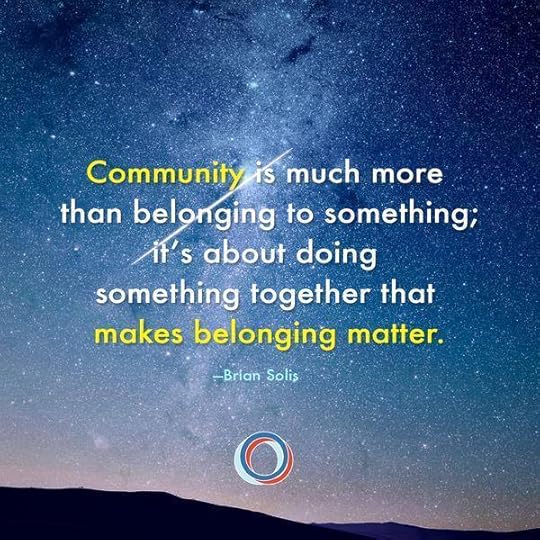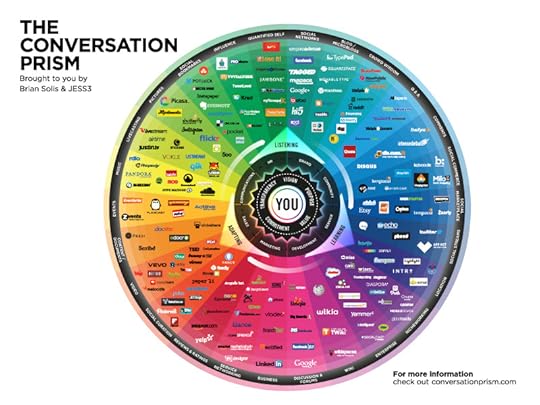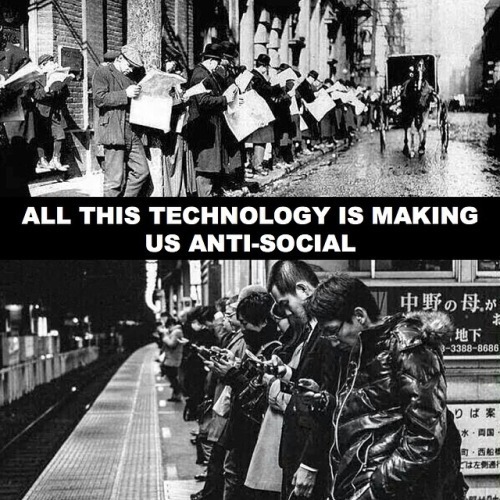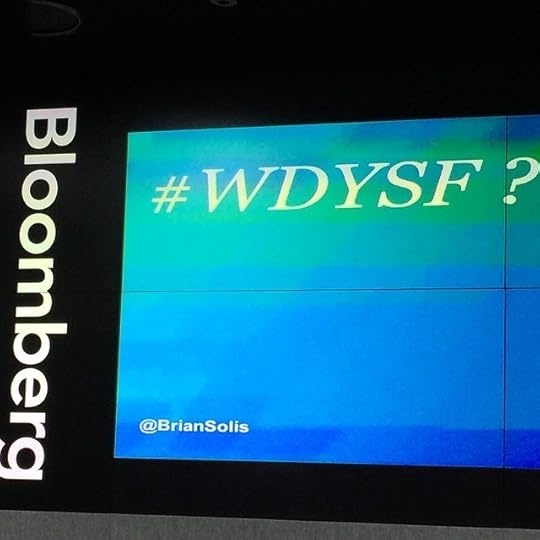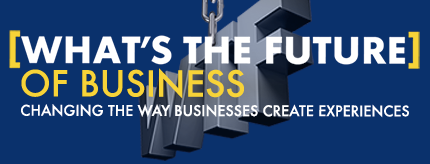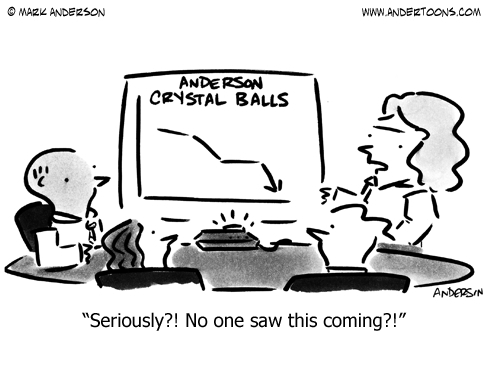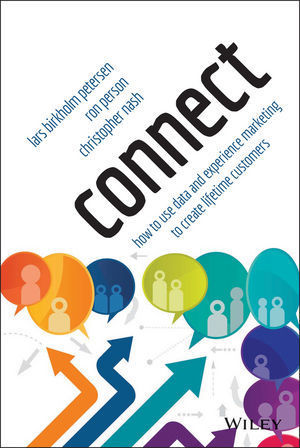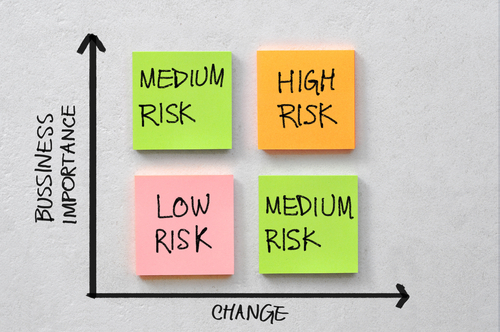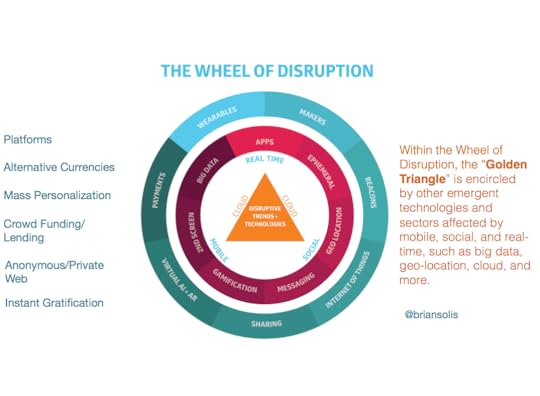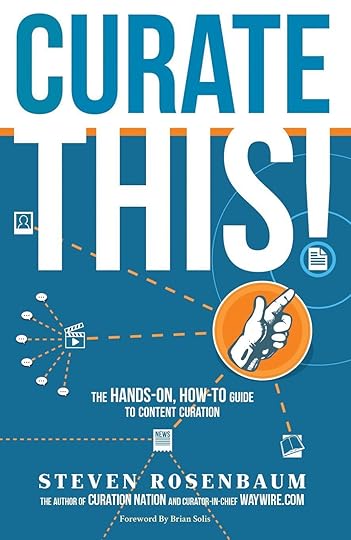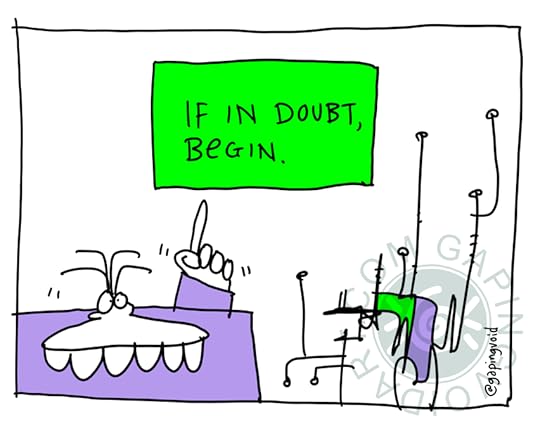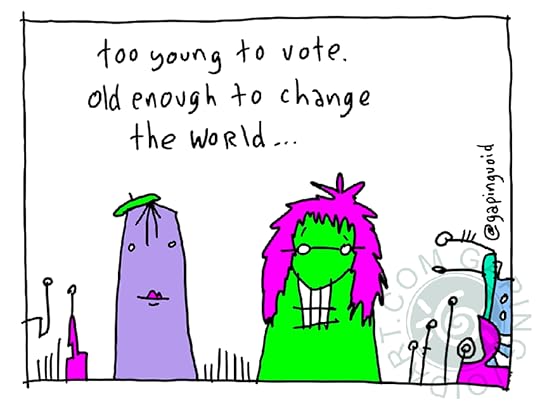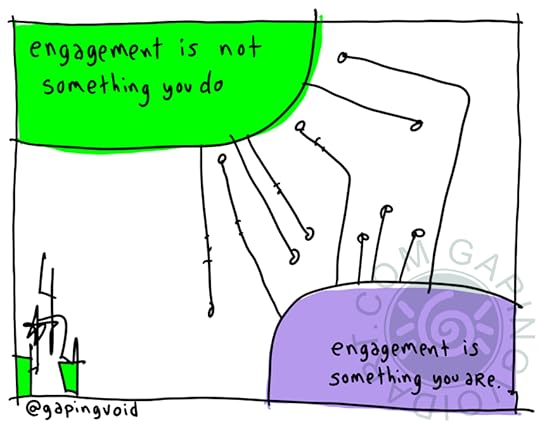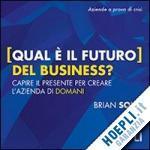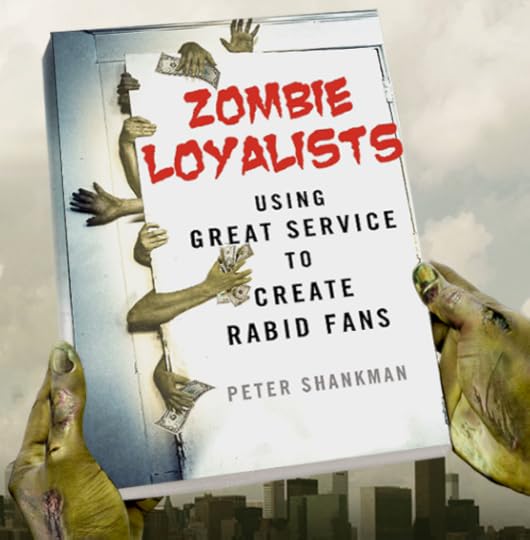Brian Solis's Blog, page 107
December 2, 2014
Community is Much More Than Belonging to Something; It’s About Doing Something Together That Makes Belonging Matter
Viginia Coutinho is a dear friend who just released a new book (in Portuguese) that helps strategists think differently about social media. She is also the organizer of Upload Lisboa, a fantastic event in Portugal that focuses on innovation and disruptive technologies. Earlier in the year, she surprised me by asking if I would consider writing the foreword. Even though I don’t write much about social media these days, I couldn’t let her down. Now that her book is available, I wanted to share the English version of the foreword with you here.
I hope it helps or makes a difference…
Foreword
Maybe we’re antisocial with our approach to social media today.
Social media is one of the most profound technological and societal advancements of our time. . It is this generation’s telephone, television, and in many ways, its printing press, democratizing information and elevating and uniting the people who create and share it. The socialization of media has connected billions of people around the world, thrust humankind into a real-time world, and forever changed how we communicate, discover, share and work.
This human network has evolved into one of the most efficient, expeditious, expansive, and approachable media networks to date. But we still have a lot to learn as users learning to balance these newfound platforms between accidental narcissism and individual empowerment. We also have much to learn as professionals seeking new ways to connect, learn and grow in a transparent and much more human era.
Yet with these advancements, with the pervasiveness of social media in many lives, with the rise of entirely new categories of everyday influencers and decision-makers, executives and social media strategies still largely see only channels and not the people, cultures and norms that define them.
Facebook
Twitter
Youtube
Pinterest
Vine
Instagram
SnapChat
LinkedIn
Tumblr
Flickr
Foursquare
Ello
Google Plus
Myspace
Trendiness trumps relevance. Quantity eclipses quality. Executive agendas upstage consumer expectations and needs.
Unfortunately many see it for its novelty and not for the revolution it feeds. They bring to it a legacy mindset and expect these new networks and the communities they foster to regress rather than progress. Said another way, we do not change to earn relevance in new paradigms we expect them to change for us.
Unacceptable.
Welcome to the EGOsystem
These social networks and the communities of human beings they support have not only connected information and people, they have forged new connected societies where people band together based on interests and passions. Indeed, there are real people on the other side of those screen. We too, are real people who forget that our needs as individuals are willfully forgotten when we become the strategists who market to ourselves.
Real people form tribes. They build relationships. But more importantly, they become informed. And, as we have learned, information is power. See, with information, people are empowered. With empowerment, people become more demanding. We want information delivered to us. We want it personalized. We especially, want it in real time….our time. We are after all, at the center of our own #EGOsystem.
If social media is so disruptive, so important, so transformational, why then do today’s experts fail to see social media as our industrial revolution? Why do executives see it as some passing fad that will vanish into geek obscurity like Pac Man, Rubiks Cube, Friendster and Myspace? Why do decision makers underestimate connected consumers and brush off connectedness as tech distractions, causes of introverted societies or the downfall of youthful conduct and education?
Many simply do not use these technologies to have an informed perspective, which prevents them from seeing a true vision for its purpose and promise. They either disregard it or they experiment with it. Few though, embrace it for its potential because they are part of it in a way that also becomes part of them.
This is where you can help.
Social media is just that…it’s social.You don’t own it. I don’t own it. Instead, it’s shared.
On Facebook, for example, when a company invests in an official presence, they tend to forget or overlook that Facebook is a shared space. It’s not a web site. It is not a captive forum. A Like is not an opt-in. It’s not an email subscription for marketing or lame content or real-time marketing. It’s still a page on a social network, the world’s largest social network at that, with over one billion users. Although it’s immense and unprecedented, it’s a democracy. It’s owned by the people for the people. As a brand, we must be of the people to earn the attention, respect, and loyalty among the very people we hope to reach.
But no…brand and social strategists instead complain that Facebook is forcing them to pay for attention. Their vocal discontent around the loss of reach aimed at Facebook’s decision to change the algorithm says everything. Complaints about the advertising platform reveals that traditional ads don’t really work in social but instead of trying something new, we’ll direct budgets elsewhere and stomp our feet on the way out.
We’re always ready to point out what doesn’t work, but we’re rarely so willing to fix the problem. Change inevitably starts with us.
All This Technology is Making Us Antisocial
Social media is not just another channel to broadcast marketing content at audiences. That ideology is anti-social in my book.
It takes a different approach.
It takes a different perspective to see what’s possible.
It’s also not unheard of to not invest in a presence if you have nothing of value to offer.
Social networks represent the real world to many people. This of course sounds crazy. But, think about it. We live life with our phones as the first screen. There are rare moments of solitude in our lives as our devices prevent us from having a moment to ourselves. But who am I to judge. Just because I was brought up a certain way doesn’t mean that the rest of the world should see life through my biases.
Social is introducing an unbreakable and also productive digital gravity that pulls us toward our trusted networks without question.
It’s our epicenter.
It’s us.
As a brand, as a strategist, think of any social network as a physical community. Because, that’s what it is. They are tribes where people join one another because of shared interests, passions, challenges, and aspirations.
Before we can say anything, before we can build anything, we must listen. We must feel empathy. We must understand the culture and the dynamics of any community before we attempt to join it. Doing so, feeds us humility and empathy. And these very human qualities will in turn inspire engaging strategies that contribute value into the communities we wish to join.
Social is a gift.
Attention is a gift.
Engagement is a gift.
Therefore, we’ve much to earn
Therefore, we’ve much to learn.
#WDYSF
To change, to make things matter to real people, everything must begin with a new perspective and approach. #WDYSF.
What
Do
You
Stand
For
#WDYSF = An important question you must answer before expecting anyone to stand along side you.
What is the value you wish to add. What is the value you wish to take away? How does engagement make things better or create new possibilities and opportunities for all involved?
No matter how much we say or publish in social networks, it doesn’t matter. If we do not see it differently, we cannot approach it differently. If we cannot show up humble yet poised to offer value, we are just another person in this digital room talking, maybe even yelling, to get people to pay attention. That’s not what this is about.
This is about community. This is about standing for something. This is about seeing something that others are missing. This is about doing what others cannot or will not. This is about inspiring a movement and building a community to bring your vision to life. And, this is true for anything and everything…not just social media.
This is your community. This is our community.
Remember…Community is much more than belonging to something; it’s about doing something together that makes belonging matter.
Connect with me…
Twitter | LinkedIn | Facebook | Youtube | Instagram | Pinterest

November 28, 2014
1 Short But Important Prediction for Marketing in 2015
It’s that time of year when experts share their predictions and others assemble them into long lists. Yay!
I’ve only managed to write one officially so far. And to be honest, it’s less of a prediction and more of something I’d love to help will to happen, not just for the future of marketing, but all of business.
I’d love to say that by 2015 we will truly see digital strategies that are integrated across digital, social, mobile, advertising, marketing, comms, et al. But, we won’t. What we will see though is a more conscious effort to bring disparate groups to the table to learn how to collaborate across screens, channels, and moments of truth to deliver ONE experience to customers wherever they are in the lifecycle.
This is why your work is more important than you might think or believe…
Connect with me…
Twitter | LinkedIn | Facebook | Google+ |Youtube | Instagram | Pinterest

November 25, 2014
The Gap Between Big Data and Big Insights: Turning data into engaging stories
Have you seen the popular HTC One TV commercial featuring Gary Oldman? It’s quite brilliant really. A highly celebrated A-list actor is paid millions to say little more than “blah blah blah” throughout the entire commercial. I’m reminded of it because that’s the reaction I tend to have these days when I hear the words “big data.” It’s almost as if I’m transported to the classroom in a Peanuts episode listening to the muted voice of the teacher muttering incomprehensible monotone words.
It’s not that big data isn’t important. Believe me, it’s the foundation for the future of business. It’s just that every time I hear about big data, it’s either in the context of social media, The Internet of Things, data technology, Nate Silver, or a combination of all of the above. What I don’t hear enough is the human side of data, the questions asked, the insights that are drawn, and the ways that insights are then executed against at every level that matters (internally and externally).
The problem with big data is we think that by saying “big,” we automatically convey importance and urgency up, down, and across our organization.
Nope.
It’s not unlike saying social media, mobile, real-time, wearables, etc. They’re just buzz words. It’s what we do with them that counts. Big data, activity, behavior, the importance of each is in how we set out to learn and more importantly, apply learning toward adaption or innovation…everywhere. The greatest promise about big data isn’t access to it; it’s the ability to excavate intellectual gems in a mountain of commodity information. Big data takes a personal touch. I call this the human algorithm. It’s the ability for someone with vision, intention, and ambition to find data that leads to hypotheses, testing, and intentional actions and outcomes. It’s as much about inklings and insights as it is about evangelizing revelations everywhere from R&D and marketing to sales and support to loyalty and back again. It’s taking seeking specific data because you’re looking for something not reacting to it. It’s pouring through 1s and 0s (Tweets, comments, posts, personalized user data, visits, connections, purchases, location data, etc…) and making them matter to you and the people around you.
In a real-time world, big data can inform the next steps of those who are looking to compete for the moment and for the future…right now. Everything starts though with an intention of doing something purposeful and then using data to support instinct or ideation. Univision, for example, is one company that is using social data specifically to think globally but is also acting locally around programming engagement.
Univision’s Uni Approach to Social TV
Before leaving to start his new social TV advisory BRaVe Ventures, along with industry veterans Jesse Redniss and Gary Vaynerchuk, I caught up with David Beck, former SVP and General Manager of Social Media at Univision to share his experience. Beck work in social media at Univision is widely regarded and I wanted to better understand how his team tuned into the elusive signal over the oh so common noise to make data actionable. Beck had the unique challenge of delivering dynamic and engaging social content to a hugely passionate, multilingual, multicultural Hispanic audience living in the US across the Univision network.
For example, content for the Mexican audience won’t necessarily resonate with the Colombian audience, as with the Venezuelan audience and so forth. It’s up to Beck and his team of content producers to be both data scientists and creative community managers – collaborating on themes and topics across news, entertainment TV, original series’, lifestyle content, sports, and more – and delivering on exciting, relevant content in real-time across dozens of social platforms. No easy task, and not one possible without an organization structure centered on data, with proper tools of which to make use, and a team with cross-functional, data-centered expertise.
To help, Dave once turned to Expion, a content marketing optimization platform to localize and manage their social marketing efforts. In finding the right technology solution, Beck then had to think about expertise and capabilities to support his vision.
“When you sign on with an enterprise system, you have to ask yourself, ‘Did I buy the Formula 1 but I don’t have the pit crew?,’” Beck asked. “Before we even made the decision, we had to ask ourselves if we’re staffed to extract value. We ended up investing early in making sure we had the people and skillsets that could handle the analytics and transform data into actionable insights.”
The Univision team is now able to pick up very quickly on what’s catching fire – digital, TV, or social – and have an enterprise toolset with immediate utility. More importantly, the team can look at the data and surface cultural nuances to quickly identify what’s working right now and how much content inventory they have to create and deploy. This reduces the amount of sifting, allows them to do more analysis, and to be able to articulate to all the other groups very quickly on what’s working, and why.
Translating Data into Value
With market-relevant insights comes the ability to develop market-relevant content and engagement strategies. At Univision, the social team is realizing significant spikes in activity linked to TV shows (particularly with a moving story line and series) can have huge implications to the marketing of the show, the story-line development, and even advertiser value. For instance, during Univision’s reality beauty competition show Nuestra Belleza Latina (“NBL”), his team noticed spikes in activity when the contestants talked about their home country — in turn they created content and calls to action on TV, social, and digital to leverage country pride to spark conversation. NBL maintained the highest engagement (Tweets per unique) of any TV show this season, according to NielsenSocial.
Dave’s story takes the “blah blah blah” out of the mix by honing in on understanding what, why or how information is specifically valuable to the people involved in deploying, managing and extracting value. Technology is only one part of the equation. The other piece is human. Univision is just one of many companies turning big data into big and actionable insights. And I guess that’s what this is all about. It’s about taking something that really doesn’t in of itself provide strategic direction and, by asking the right questions aligned with the best intentions, turn data into not only actionable insights, but also engaging stories that matter to people…their way.
Connect with me…
Twitter | LinkedIn | Facebook | Google+ |Youtube | Instagram | Pinterest

November 20, 2014
Customer Experience Happens To You Not Because of You…But It Doesn’t Have to Be That Way
Earlier this year, I was asked to write the foreword for a new book focused on experience marketing and CX. The opportunity appeared while I was in the throes of researching and writing my (not yet announced) book. As hard as it was to pull away from it, I must admit that it was a welcome distraction.
So, I stopped what I was doing and read the manuscript for Connect: How to Use Data and Experience Marketing to Create Lifetime Customers by Lars Birkholm Petersen, Ron Person, Christopher Nash.
As usual, the deal was that I would be allowed to publish the foreword upon the release of the book. And viola…here we go!
Customer Experience Happens To You Not Because of You
“You cannot create experience. You must undergo it.“ – Albert Camus
Many strategists realize that the world is only becoming more connected, not less. Yet many executives still wonder when all of this crazy texting, selfie-taking, snapchatting, lunch tweeting, shenanigans is going to finally fizzle out. I don’t know about you, but I’m already dusting off my rotary phone and digging out my floppy disk collection just in case we do decide to go backwards.
Not really.
You get it. I get it. Do we really need yet another pep rally to celebrate our like-minded perspectives and passion to bring about change. Yes. In fact, we need to really ourselves to march the importance of the changing customer right on up to the C-Suite to drive home the importance of customer-centricity for not only the benefit of people but also the future of our business as well as our place in the market.
See, customers in all of their connected glory are evolving with or without us. At the same time there’s a mind-boggling lack of urgency and a resulting scarcity to support, resources, and budget to understand and engage this rising connected customer.
Ladies and gentleman, we have ourselves a customer experience imperative. But before we go any further, I must press pause for a moment to share something stark yet commonsensical; technology isn’t the answer. That’s right. Even though we’re faced with radical changes in customer behaviors, expectations and preferences as a result of technology, to lead the next generation of customer experience does not begin with technology. It starts with people.
As such, the opportunity for customer experience requires elevated discussions where organizations assess current experiences against a vision for what they can and should be. For example, is today’s customer experience a byproduct of our brand promise? Do we deliver against our stated intentions and is that experience reinforced at every touch point?
Approaching customer experience in this fashion takes what is typically today a bottom-up approach and shifts decision-making to a top-down model. And we all know that true transformation comes from the top. The difference though is that implementing customer experience initiatives with both, top-down and bottom-up strategies sets the foundation of which customer-centricity can build and flourish. One is directional, the “North Star” if you will, where customer experience initiatives map against a vision for how brand promises are enlivened and reinforced before, during and after transactions. It sets the standard for investments in technology, engagement, insights and pilots. It also sets the standard to follow and benchmark to measure against for all those who are responsible for the experience, wherever and whenever it’s formed or affected.
The result is a brand promise that’s measured by the experience customers have and share. It ladders up the importance of customer experience transcending it from a functional role to that of an enterprise-wide philosophy.
Good intentions are just the beginning, but it’s not enough.
Let’s assume that businesses, for the most part, want to do the right thing. After all, they’re making increasing investments in CRM, social, mobile, digital, et al. With spending comes sincerity and intention, right? After all my years of advising executives and researching the evolution of markets, I can honestly say that executives seem to care. I can’t say that I’ve ever heard anything from executives indicating any intention of dethroning the customer as king.
I can’t imagine sitting in a boardroom and hearing leadership reveal a new direction of anti customer-centricity…”Team, we just don’t care about our customers. And to be honest, we could care less about their experience. We believe this to be a shorter, sweeter path to profitability and earn outs.”
Depending on which definition you align with, customer experience is often characterized by the perception a customer has after engaging with a company, brand, product or service.
If customer experience is a critical pillar to build relationships and business outcomes, why is it that we are still fighting the good fight? If so many executives agree that the future of business lies in customer experience, why are we spending this time together right now? What’s the point? The answer is that there’s a disconnect. The link between aspiration and intention is separated by vision and action.
To my surprise (well, not really), Oracle found in its research that only 37% of executives are actually beginning to move forward with a formal customer experience initiative. Considering that businesses race along with the speed and agility of a cinder block, I’m sure that even this initial group of leading businesses will not make significant progress to establish a competitive edge someday soon. But some companies will aggressively invest in CX and innovation in products, processes and services and that will set the stage for disruption.
Why?
The customer landscape is shifting. It always does. This time, however, the door to Digital Darwinism has been kicked off its hinges. Technology and society are evolving faster than the ability to adapt. Consumers are becoming more connected. As such, they’re more informed. With information comes empowerment. And with new found connectedness and power, customer expectations begin to shatter current sales, marketing, and support models.
Social, mobile, and real-time each contribute to a new reality for customer experiences and engagement. This isn’t news. In the previously referenced study, Oracle found that 81% of executives agree social media is critical for success, yet 35% don’t support social media for sales or service.
Businesses either adapt or die. Ignoring it hastens Digital Darwinism. Jumping in without understanding or intention is a moonshot without aiming for the moon.
This isn’t just a channel strategy.
This isn’t just a technology play.
This is a shift toward a new movement where customer experience now screams for us to “Create Experiences!”
Indeed, customer experience happens with or without you.
The customer experience imperative needs you to make the business case.
In your organization, people are talking about customer experience right now. But for some reason it’s just not a priority. Actions don’t reflect promises. In CX, you must create a sense of urgency to accelerate to match or outpace the speed of market transformation. Without doing so, a sense of urgency will be created from the outside-in.
It’s not just about the customers you have today; those who are not already your customers represent your future growth.
Connect is the ultimate tool to take advantage of the new marketing revolution, where the customer is in control. You’ll learn to transform your customer’s experience, create lifetime connections with your customers, and jump ahead of your competitors.
When we take a new approach to engagement, customers feel the difference.
Nothing begins without you…and that is why you are the hero and this is your journey. The future of digital marketing and customer experience is in your hands. Feel it. Design it. Advance it.
If you don’t lead it, who will?
About Connect
Connect is the ultimate marketing guide to becoming more relevant, effective, and successful within the new marketplace. Written by a team of marketing experts serving Fortune 500 brands, this book outlines the massive paradigm shift currently taking place within the industry, and provides the insight and perspective marketers need to stay on board.
Connect with me…
Twitter | LinkedIn | Facebook | Google+ |Youtube | Instagram | Pinterest

November 17, 2014
Spotify, Taylor Swift and The Music Industry’s Missed Opportunity
Guest post by Monica Corton (@momusing), Executive Vice President, Creative Affairs & Licensing Next Decade Entertainment, Inc.
If you have any connection to the music biz, it’s been hard to ignore story after story of the pull out of Taylor Swift’s catalog from Spotify. As a music publisher, I have to say that I too share all of the frustrations that both Swift and Big Machine’s, Scott Borchetta have with the bad royalty structure that exists with regard to streaming music. Spotify is not alone in this and certainly not the worst player by far (some could point to Pandora for that). However, I feel that Borchetta and Taylor missed a watershed moment in helping themselves and the industry find a solution to this difficult problem. If Swift and Borchetta have an issue with the amount of royalties they are receiving from Spotify, why didn’t they negotiate for a special extra tier of payment (an increased price to customers of Spotify) for Swift’s catalog so that they could obtain extra income and still satisfy all of her fans who would rather stream her music hundreds of thousands of times than digitally download her album? We need tiered fees in streaming to become a reality if the streaming business is ever going to work from a royalty standpoint. We also need a higher royalty for masters and publishing and to reduce the amount of time that people have free access, but both of these probably could have been achieved with the popularity of Swift’s album, 1989. In fact, few albums could get a digital service to make such a radical change, but I think, Swift’s could have gotten it done.
This whole incident feels like Napster Part II. We all know that streaming is where people are going. It’s not a theory anymore; we are all seeing the change on our royalty statements. Album sales via physical and digital downloads are significantly down and the reams of pages of streaming royalties increase every accounting period. They don’t add up to anything of significance, but they are definitely taking up lots of space on statements. However, if we know our customers are trending this way, we have to find a business model that supports that trend or we risk pissing them off again ala Napster. In fact, the minute I read this story, I went on to the Internet to see the backlash and many were writing that if they couldn’t stream Swift’s music on Spotify, they planned on going to a Bit Torrent site to rip their own free copy. Is that what we really want here?
It’s hard for me to believe Spotify wouldn’t entertain a special royalty tier for Swift’s music and find a way to lock it in the paid only side. They had to know the backlash and bad publicity would be very harmful when it came to Taylor Swift. If a tiered streaming fee had been done, Swift/Borchetta would have gotten more money, probably not as much as selling physical copies and digital downloads, but more than the $500,000 she has been averaging from Spotify, and she would not have upset her fans. More importantly, she would have helped thousands of artists and songwriters who don’t have the juice to get this kind of change done. She would have really made a statement for changing the business model for all, in a much more positive direction which is what she discussed in an article several months ago.
We need Spotify to succeed. If the industry has a problem with the business model of Spotify (which we do), the goal needs to be to fix the business model through negotiation, not to destroy another potentially viable business. To clarify, I’m saying this without owning any equity in Spotify. I am all for fighting for songwriter and artist’s rights, in fact, I do that all the time, but I am also for finding a business solution to keeping the music echo system viable.
We need to be much more strategic as an industry in finding solutions to these complicated problems. When the digital services go out there and say they paid millions to the labels and publishers, they did do that with the majors, but they were in the form of advances against a sub par royalty structure. That money is sitting in unrecouped advance accounts, being very slowly released to songwriters and artists as the poultry royalty uses click in each quarterly accounting period. Everyone is telling the truth here, but the way the system has been set up is doing serious damage to the livelihood of creative people. I hope that all of the hubbub over this actually leads to some much more inventive business solutions, rather than a continued pull out from Spotify by other artists and songwriters.
Photo Credit: Shutterstock

November 10, 2014
Digital Transformation is About Empathy First and Technology Second
Every day, there’s seemingly yet another disruptive trend that emerges out of nowhere which affects consumer behavior and the future of everything along with it. Many of you already follow some of the most notable trends disrupting markets today and I know you’re devising new strategies as a result in order to compete in these ever shifting markets.
- Real Time
- Social Media- Mobile
- Sharing Economy
- Peer-to-Peer Economy
- Maker Economy
- Internet of Things
- Crowd Funding/Lending
This wheel of disruption keeps turning and the Butterfly Effect it unleashes with each revolution is forcing the creation of new agile models to stay current let alone get ahead.
Aside from the caché that each of these white hot trends boast, they roll up into one of the most important business movements in modern history. Enter the era of Digital Transformation.
Digital transformation has been a key area of research for me over the past few years. In fact, Altimeter Group recently formed a strategic alliance with CapGemini, one of the leading authorities on the subject, to lead joint research endeavors that help guide businesses throughout their transformation efforts.
Following the CapGemini announcement, Gloria Lombardi of Simply Communicate, reached out to learn more about the alliance and also what organizations are doing to adapt to the 21st Century. I wanted to share our discussion with you here.
Gloria Lombardi: Digital Transformation. What does it involve? And, which companies are doing well?
In our report “Why and How Companies are Investing in New Business Models to Lead Digital Customer Experiences” we analyzed some of the best companies doing well in this space. These include Starbucks, Intuit, Sephora, Lego, General Motors, and Ford.
Each of them is going through digital transformation in their own way. But, the stories we heard were phenomenal across the board. I will save the concrete examples for the report since it is free to download. However, here I’ll share some highlights.
Everyone begins at the same place. It starts with asking a simple question, “How is my digital customer and employee different from those who are traditional?”
From there, you learn about journeys, expectations, behaviours, and preferences. You start to see that the investments you make today are indeed showing signs of decay or irrelevance.
However, seeking these answers, is how we begin to learn the “why” and “how” of digital transformation.
For example, Starbucks‘ CDO Adam Brotman started with digital customers and mobile platforms. “I started with mobile; that was the heart of it where we really acted as a team,” he told me. “That worked well and catalyzed, moving into web where we were charged with figuring out what our mobile web strategy looked like and how it connected to our loyalty and payment groups. From there, it snowballed pretty quickly.”
Digital transformation is also about building relationships and alliances inside the company to expedite and scale change. Digital leaders must open the door for passionate employees throughout the company who have the energy, passion, and experience to champion change. As LEGO’s Lars Silberbauer, Global Director of Social Media and Search, shared with me, “It’s about finding those people in different departments who are willing to risk things to be a lead within the company. There are a lot of people who want to take a company forward.”
Once you have support, digital transformation will lead to new vision and operating philosophies as well as models and processes.
Another example is Motorola Solutions. The partnership between IT and marketing was elevated to an entirely new level. Dubbed the “MIT Group,” Marketing and IT formed an official alliance to focus on an integrated approach to digital customer experience and change.
Based on these studies, what are the challenges to digital transformation?
Too many companies are approaching their digital transformation from a technology perspective.
But at the heart, digital transformation is the story of how people are changing.
Whether we realize it or not, the way customers and employees make decisions, the technology they use, and how preferences and expectations evolve or detour, are stories for us to discover. These are the insights that guide the transformation. Technology adoption is not the solution: it is merely an enabler for transformation.
It takes vision to make the change. I will share with you an example from our second report on digital transformation.
“The State of Digital Transformation” revealed the organizations supposedly undergoing digital transformation. (After studying the best companies out there, we wanted to compare them with everyone else).
88% of these enterprises stated they were going through digital transformation efforts. However, within the last year, only 25% of them completely mapped out the customer journey to get a clear understanding of new digital touch-points.
With these findings at hand, what’s your view for the future of digital transformation?
Digital transformation means different things to different people. That’s OK. The future is going to either happen to businesses or because of the changes they undertake today.
Change has to start somewhere. Strategists will realize that their digital customers and employees are not only different from their traditional counterparts, but also different from the executives who think they know them.
The future is really about empathy. Without empathy, there can be no real change. Without it, businesses will succumb to something that I call ‘Digital Darwinism’, when technology and society evolve beyond the ability to adapt and thrive.
A shared vision around digital transformation…Can you tell us more?
Altimeter and Capgemini’s work is not only complementary; clients and prospects already substantiate it.
Capgemini takes a holistic view of digital transformation across the entire enterprise – from manufacturing to marketing, service, support and everything in between.
Initially, Altimeter Group focused on the digital customer experience and employee engagement. Our view was inspired by the work we were already doing around social media, content strategy and mobile. We learned that significant budget and resource investments are led by sales and marketing to update aging infrastructures and to pursue the digital customer more effectively.
Our initial research was designed to help marketers and IT professionals think beyond technology. We wanted to encourage them to invest in strategy, system and process roadmaps, which are relevant for discerning, sophisticated, (and impatient) customers and employees.
Innovation. Is there anything we can anticipate Brian?
Innovation doesn’t always correlate to technology. Most of the time, it starts with perspective: seeing things differently. It is something that touches processes, models, and corporate vision.
This is a key area of focus. We look forward to sharing more in the coming months.
Connect with me…
Twitter | LinkedIn | Facebook | Google+ |Youtube | Instagram | Pinterest
Image Credit: Shutterstock

November 5, 2014
Curate This! We are the Network Now
My good friend Steve Rosenbaum released his new book, “Curate This,” to help us learn the ins and outs content curation. This is his second book and also the second time I’ve had the privilege to write his foreword. In fact, this time around, I wrote two. I’d like to share the first with you here. I’m sure I’ll publish the second at some point in the near future.
and I wanted to share it with you
I’ve known Steve Rosenbaum since the mid 2000s. We’ve worked together and over the years, we’ve grown to become great friends. Before we met in the real world however, I was also a fan of Steve and his work at on MTV News: Unfiltered in the mid 1990s. Little did I know that this person whose work on a show that had a profound impact on me would become someone whom I would continue to admire and respect as his work continued to challenge convention and pioneer new fronts.
Curate This! We are the Network Now
MTV News: Unfiltered wasn’t an ordinary news program. It was crowd-sourced, where everyday kids and young adults would curate the news based on what was important to them. It was my first real foray into the world of user-generated content. As producer and creator of the show, Steve was essentially a master curator of content and exceptional programming. Arming the MTV generation with cameras and a voice, we were introduced into world that didn’t receive popular airplay as told by people who would have their 15 minutes of fame. All of this was well before YouTube and all of the social media we take for granted today.
Steve figured out that if you open the doors to people and what’s interesting to them without influence of what mainstream media fed us, he could not only inform us in new ways but also build vibrant communities around people and curated, interest-driven content. This premise would influence my work in media and research.
Steve’s vision and subsequent work with Magnify and now Waywire with Corey Booker would also shape a new wave of technology startups, platforms and media channels. These new technologies would eventually empower everyday experts to create and curate content for networked audiences around the world. More so, content too would evolve in ways where viewing or consumption was no longer enough. Networked audiences too would become part of the story in how they shared, remixed or reacted to the content of others. Impressions used to be a big deal, but its no longer enough. That’s for yesterday’s programming. Now it’s all about impressions that transform into expressions and how and what people say and share in response to what they find fascinating, though provoking or simply entertaining.
That’s the power of the human network and it represents the future of curation, broadcast, connections and media at large.
By the people for the people…
The art of curation combined with social media, its partner in enablement, allows for content to travel to and also through people bringing to life a human broadcast network. This vibrant and highly efficient distribution channel is powering a new era of consumption, dissemination and engagement around relevant information and the communities that form as a result.
In our own way, we are each now programmers of our own digital channels now. Our audiences are the people to whom we’re connected and those who are connected to us. Our communities are defined by what we share and what they share and how we interact respectively. We are what we see and hear. We are what we say and don’t say. We are watch we share. We are the network.
That’s pretty amazing when you stop and think about it.
Now…go curate this!
Connect with me…
Twitter | LinkedIn | Facebook | Google+ |Youtube | Instagram | Pinterest

November 3, 2014
The Sophisticated Marketer’s Guide to Thought Leadership
LinkedIn and I have worked on several research projects together over the years ranging from the future of Native Advertising (private) to the state of Relationship Economics. Now, we banded together again to explore the art and science of thought leadership. Although this time, I was on the contributing side of the research project and Jason Miller, LinkedIn’s senior manager of content marketing, was the lead.
“Thought leadership is an essential part of any successful content marketing strategy. Both B2C and B2B companies can benefit from the many advantages of thought leadership to build a more competitive reputation and ultimately drive more revenue,” according to Miller.
Miller along with his team at LinkedIn interviewed several experts to assemble a gorgeous and useful ebook to help brand marketers learn how to optimize thought leadership strategies. Experts include Joe Chernov, Ekaterina Walter, Shannon Stubo, among others. You can download .
To celebrate the launch of the new ebook, LinkedIn gave me the go ahead to share my part with you here.
Hope it helps!
How important is thought leadership for gaining a competitive advantage?
If you define thought leadership as thinking about people and how to provide these people with value, how to help them solve problems, and how to help them achieve aspirations and goals, it’s absolutely critical. If you define thought leadership as personal branding, the opposite is true. People often confuse thought leadership with personal branding. There’s a difference.
For those looking to create thought leadership content for the first time, what are the best opportunities to get started?
I was once asked how to be a thought leader. The answer is: You have to be one. That takes understanding of the market and the people you are trying to reach and engage. You have to understand the state of the world, and also have ideas on how it should evolve. But it starts by being human. This is a part even successful thought leaders miss, and it’s mostly driven by ego: “I’m better than the voices that are out there, so I’m going to add mine.”
True thought leadership starts with empathy. Can you tell me the top ten problems your audience has at any given time? How about the top ten aspirations? Are you thinking through where your audience wants to be, compared with where the market is going? That’s what inspires me. Someone who is honestly trying to better understand the people they are trying to help. And if understanding and helping is the goal, I don’t think any thought leaders would call themselves thought leaders.
Can you think of a brand that is nailing thought leadership? What are they doing right? What are they gaining from it?
For a while American Express Open Forum was one of the best examples because they didn’t just try to put their own voice out there. They made it a point to bring in relevant outside voices. Their model became the benchmark, as did Mayo Clinic’s when they offered thought leadership by helping people answer common questions about health conditions. Same with H & R Block and their selfless approach to answering questions. When you are selfless as a brand, when you are providing value, the natural response is reciprocity. Reciprocity can lead to ROI.
Intel (client) has catered to the B2B audience as well as B2C which is pretty stellar for a semi-conductor company. They continue to break ground, using new and existing channels in leading ways, and demonstrating to the rest of the world what is possible.
What LinkedIn marketing tactics can brands use to implement thought leadership campaigns?
Recently, Altimeter Group (where I am a principal analyst) and LinkedIn partnered on a research project that ultimately showed how genuine communication and engagement in social media helps businesses improve relationships with both customers and employees. The key to ‘relationship economics’ on social media is no different from real-world relationships: the more you invest in terms of time, openness, value, listening, and engagement, the more likely it is that relationships will flourish.
It starts at the top. We found that executives at companies that reap the rewards of social media engagement are much more active on social media than executives at companies that are not socially active. They also play a bigger role in driving a socially engaged culture. Yes, there are specific tactics companies can use on
LinkedIn, but the most effective social media strategies are derived from a culture of relationship building where the executives lead by example.
You’ve mentioned before that engagement is really about A.R.T. (Actions, Reactions and Transactions). When crafting a thought leadership strategy, do you recommend starting with the story you want to tell or the A.R.T. you want to achieve?
A.R..T. is less about following the trend of trying to be a storyteller, and more about just trying to be engaging. I believe the story comes naturally when you are inspired by the empathy of being human, and what humans find compelling, useful, and meaningful. Most brands think about one audience, one campaign, and one emotion, but there are so many types of emotional elements to consider. The culture of each social network is different. Each channel features different people, with different needs and motivations, in a different context. The actual story is the bigger purpose or aspiration. And it unfolds in so many different ways, like the movie Crash. More companies need to think like that.
A.R.T. is really about what happens next. Everyone should design for what happens next. Attention is precious. Once you have earned attention, it’s what you do with that attention that counts. Too many companies emphasize attention. They come up with amazing headlines, clever GIFs, and great infographics, but there is rarely a defined strategy to do something with attention once it is captured.
In your mind, what is the biggest differentiator between those who try to become thought leaders and those who ultimately succeed at it?
Philosophically I wonder if anyone really knows if they are successful. How do you define success? The people who want to be helpful, do they have to justify ROI? It comes down to campaign vs continuum. One turns off and the other is part of life. The A.R.T. of engagement was always about assessing the value in real-time, adding to what you’re doing, and measuring. You should know more as you go, so that you can effectively refine as you go.
There are too many content marketers who suffer from mediumalism and there are too few strategists who can turn attention into a human moment. It’s about designing for the embrace, not the channel, and then for the journey.
Connect with me…
Twitter | LinkedIn | Facebook | Google+ |Youtube | Instagram | Pinterest

October 27, 2014
Digital is Just a Means to Reach People…It’s How and Why You Use It That Matters
Splendida Notizia!
#WTF is going on in Italy? The future of business is turning a new page…that’s what. I’m excited to announce that What’s the Future of Business: Changing the way businesses create experiences is now available in Italy.
To celebrate the launch, I spent some time with Luca Conti, new media strategist, Italian blogger, journalist, and author of several books on social media. In our discussion, we explored the future of business and why the time is now for leadership to rise from the middle. I wanted to share this discussion with you here…
If in Doubt…Begin
What would you suggest to a family-sized medium business in Italy? How could they embrace this positive change? Where should they start from?
Disruptive technology is just that…it’s disruptive. Every so often, something new comes around and completely upsets the balance. Now, innovation is part of our society and it’s only accelerating. The key to success is to simply accept that this is the end of business as usual. The way that things were done only evolve to accommodate the expectations and preferences of evolved customers and employees. And, that’s where we begin. We need to understand what’s changing so that we can learn and adapt. This isn’t anything to fear nor is it something that we should discount. But ignoring how technology is affecting customer or employee behavior isn’t an option. In the end, that’s what this is about…behavior.
What’s different about your connected customers over your traditional customers?
How are they using technology to make decisions?
What do they search for? What do they ask? Where do they go?
Most importantly…what comes back in their search or what answers are given to their common questions?
Answering these questions makes change approachable because you can see and feel what’s different. Any impassioned business professional will realize that technology doesn’t present challenges or obstacles. The word change here is similar to saying improvement…improvement to chase new opportunities and grow your business.
On Digital Influence
Is this a key topic for consumer goods and big companies or it could interesting to leverage for SMB too? How could You manage it with only a few resources to spend on that?
Digital influencers are those experts and authorities in any market that customers and prospects find when in search of information, direction, or validation. This is a bit different than advocates, which may or may not be customers, but share a passion for the company’s products, services or purpose. Regardless of the size of the business, it’s imperative for to learn who influences and advocates for your business and your competition. There are of course many services such as eCairn and Traackr that make it easy to identify who they are, what they talk about and where. But, this is a future that shares much with the past…relationships are everything. Getting to know them is just the beginning. Recognizing their work. Engaging them to learn more before you need something is also key.
In a connected world where people trust others like them, finding influential people in networks where customers and prospects engage with one another will only help you learn more about expectations, challenges, and opportunities. More so, you’ll learn about the people whom others trust and how to build a relationship with them. Taking the time to learn and engage helps you expand your reach from one-to-one to one-to-one-to-many. Word of mouth is more powerful than ever before. I understand that time is limited, but you get out of relationships, whether in real life or online, what you put into them.
Generation C and The Connected Consumer
What about B2B companies? I believe we should address this topic from a P2P (people to people) point of view, what is Your opinion?
One of the first things I often hear from b2b marketers and strategists is that all examples of new media are inherently b2c. They then venture to ask how new technologies apply to their world. It is for this reason that I begin referring b2b and b2c as simply p2p, people to people. That’s what this is about…people. The question is how are your connected customers different than your traditional customers? Decision-making takes place online of course. Connected customers use different networks and tools to discover, engage, and share. This really is about journey mapping to uncover the new touch points, technologies and the behaviors that shift as a result.
While the networks and apps may change, your customer’s journey is increasingly shifting from older touch points to new social and mobile communities. It’s true for everything.
The one thing that I’d also like to mention is that because everyone is becoming more connected, customers are changing. This is particular interesting for b2b companies as their customer’s customer may be changing faster than the value chain that is designed to serve them. In many ways this is an opportunity for b2b companies to help their business customers adapt to better serve their connected consumers (b2b2c)
The Story Behind The Book
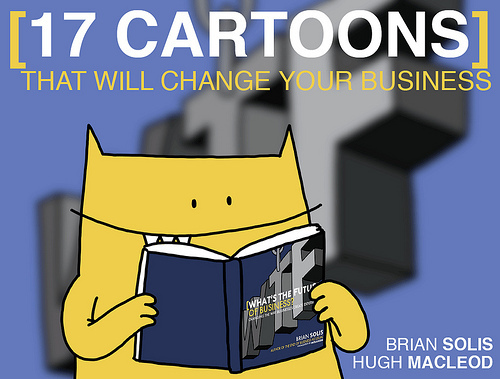
You used a cool format, very visual, colorful and straight to the point. What’s the story behind the book?
The book is a testament to the fact that technology is changing people’s behavior and we have to change along with it. I recently stumbled across a statistic that shows teenagers can only focus for six minutes while doing homework until they have to reach for a connected device to plug-in.
How can I help businesses change if I can’t change myself? I’ve written many books but this is the first where I stepped back to approach the opportunity differently. Rather than publish a book the same old way with the same paper, shape, and font, I decided to study how connected consumers or Generation-C (connected) as I refer to them, read and share content online and on devices. What I learned is that multitasking is part of the experience now and that information can be presented on paper in a way that’s familiar, and appreciated, on digital devices. Essentially what I set out to answer is if we know consumer behavior is changing what would the ideal book look like to be accepted and valued in today’s digital lifestyle.
When you start with a different question you get a different result. And, that’s the point. This is a time for innovation and reinvention. I partnered with my friends at Mekanism to create what is a digital UI in printed book form. We call it an analog app. It’s rich with visuals, infographics, and also cartoons that summarize each chapter drawn by my dear friend Hugh MacLeod (@gapingvoid).
Also, each chapter includes a navigation bar to help readers easily jump from section to section. It’s also important that I share that as a write, I had to change how I write. Here, my sentences are presented in burst formats, similar to Tweets, to help connect with readers in a more dynamic way. It also makes the content shareable.
Nothing is simplified however. It’s still a deep book. It’s just modernized to reflect how we interact with information now as a result of our connected lifestyle.
The State of Social Technology in USA (and the World)
I met Your partner Charlene Li in Rome a couple of years ago and she told me even USA companies have not fully embraced social technology inside their business. Are we still at the beginning of a new era? Why millions of people are on Facebook, LinkedIn, Twitter and online but companies still invest not enough on digital? Do we have a cultural problem or a generational one?
The problem is purely philosophical. Social is part technology but it is what social unlocks and also empowers that is truly transformative. It’s a great equalizer. Social flattens markets and connects people to other people. As we become more connected we become more informed. With information comes power and empowerment. And with empowerment, consumers become more demanding.
It’s not just generational however. This is about everyone who lives a connected lifestyle. Sure Millennials are digital natives. But everyday people who are over 40 who use a smartphone or a tablet or social networks and apps start to exhibit Millennial-like behaviors. Businesses must not only embrace the technology that their customers use they must understand how technology is affecting discovery, perception, decisions, and loyalty.
Many companies think that the answer is digital. But digital is just a means to reach people. It’s how we change and evolve our philosophy to adapt to new expectations, behaviors and values to not just reach to markets, but to lead them in meaningful ways. That’s the future of business. This is a time for leaders…not managers.
Photo credit: Ana-Maria Leonte

October 23, 2014
Only companies with impeccable customer service will survive the Zombie Apocalypse
Guest Post by Peter Shankman, Author of Zombie Loyalists: Using Great Service to Create Rabid Fans
Imagine a world where decisions aren’t made based on anonymous reviews with no validation on sites like Yelp or TripAdvisor, but rather, through trusted sources in your own network.
Imagine that world is automatic – If you want to take a vacation in Fiji, you don’t have to ask which of your friends have gone, you simply start searching for Fiji – on any network, on any of the major “social” sites, and the posts, photos, videos, and comments of your friends who’ve visited Fiji come up automatically, sorted not only from good to bad, but “most trusted” to “least trusted,” depending on your interaction with that person in your network.
Imagine that this applies from everything in your life – from the diner at which you eat Sunday brunch, the airline to which you become loyal, the pet-spa to which you entrust Fluffy to get her summer coat.
Brian Solis said it before, countless times. In this new economy, the differentiating factor, that above all else, will be the concept of trust. If we have a good experience with a vendor/merchant/restaurant/business/service, and we appreciate what that business did for us, the sentiment of our interaction will be posted automatically, sometimes even without us doing anything.
Think about this: If I have a favorite Mexican restaurant on 49th Street, and I go there frequently, well, who knows that? My phone knows where I am, based on GPS and how long I’m there, as it pings my location to cell towers close to me. Thus, Facebook, Google+, they all know, too.
If you’re in my network, and we’ve connected in the past, then when you’re geographically close to me, and go searching for a Mexican restaurant, guess which one is going to come up first in your list? It’s already happening on Google Maps, while Facebook knows with whom you want to connect before you do when you land in a new city.
So what’s a business to do? If Yelp doesn’t matter (did it ever?) and advertising and marketing doesn’t have anywhere near the hold that a trusted recommendation does, what will save the business of today and long into tomorrow?
Customer Service.
Nothing else. The economy of the next fifty years will be powered by Customer Service. Why? Because in the very near future, only the sentiment of a customer’s interaction with you will determine whether that customer brings in new ones, or lets your business die.
I’ve spent the past year researching customer service around the world, and have discovered some amazing facts:
88% of all businesses believe that they deliver “top-notch” customer service. Unfortunately, only 8% of their customers believe the same thing.
The average amount of money a company loses after an unresolved bad customer service interaction is $289. That adds up to $83 BILLION dollars per year in this country alone.
Those numbers should scare you more than any Zombie Movie should.
But it doesn’t have to be that way. All the research that I did for my latest book, Zombie Loyalists, shows that good customer service – heck, just one level above crap – is enough to get a customer to come back, because the bar is set that low! Create something out of the ordinary, whether it’s a smile, a discount, or a free drink, and you’ll create Zombie Loyalists, customers who will go out of their way to drag their friends back to your business with them, every. Single. Time.
And that, my friends, is real revenue for the next century and beyond.
Peter Shankman is best known for founding Help a Reporter Out, which changed how journalists and sources interact around the world. Zombie Loyalists is his fourth book, and is the follow-up to his best-seller, Nice Companies Finish First. He blogs at Shankman.com, and tweets random hilarity at @petershankman


